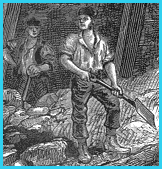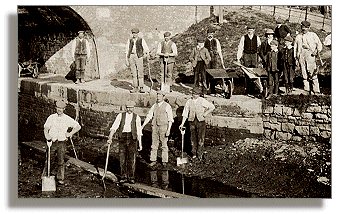| |
 Once
the large trench for the canal had been dug out it had to be lined with
a special mix of loam and clay which
was then spread over the flat bottom and sloping sides of the canal. This
could be up to 3 feet thick in places and was packed hard or "puddled"
to form a watertight seal. The navvies often had to use their feet to
do this, and sometimes cattle or other animals were driven along the floor
of the canal to compress the clay into any cracks which might cause leaks. Once
the large trench for the canal had been dug out it had to be lined with
a special mix of loam and clay which
was then spread over the flat bottom and sloping sides of the canal. This
could be up to 3 feet thick in places and was packed hard or "puddled"
to form a watertight seal. The navvies often had to use their feet to
do this, and sometimes cattle or other animals were driven along the floor
of the canal to compress the clay into any cracks which might cause leaks.
Although the canal building
years had ended, the Victorian
period provided a lot of work for navvies, because of the many impressive
construction projects for new railways,
dams, roads and public buildings.
Back
to Montgomeryshire Canal menu
|
The
"puddled clay" used
to waterproof the bottom and sides of canals caused huge problems
at some aqueducts. The enormous weight
of the lining plus the water made the stone sides of the "bridges"
bulge outwards. There were serious leaks and the risk of collapse.
See the aqueducts page.
|
|

 Once
the large trench for the canal had been dug out it had to be lined with
a special mix of loam and clay which
was then spread over the flat bottom and sloping sides of the canal. This
could be up to 3 feet thick in places and was packed hard or "puddled"
to form a watertight seal. The navvies often had to use their feet to
do this, and sometimes cattle or other animals were driven along the floor
of the canal to compress the clay into any cracks which might cause leaks.
Once
the large trench for the canal had been dug out it had to be lined with
a special mix of loam and clay which
was then spread over the flat bottom and sloping sides of the canal. This
could be up to 3 feet thick in places and was packed hard or "puddled"
to form a watertight seal. The navvies often had to use their feet to
do this, and sometimes cattle or other animals were driven along the floor
of the canal to compress the clay into any cracks which might cause leaks.